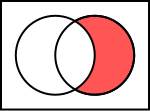Converse nonimplication
In logic, converse nonimplication[1] is a logical connective which is the negation of the converse of implication.
Definition
which is the same as
Truth table
The truth table of .[2]
| p | q | |
|---|---|---|
| T | T | F |
| T | F | F |
| F | T | T |
| F | F | F |
Venn diagram
The Venn Diagram of "It is not the case that B implies A" (the red area is true)
Properties
falsehood-preserving: The interpretation under which all variables are assigned a truth value of 'false' produces a truth value of 'false' as a result of converse nonimplication
Symbol
Alternatives for are
- : combines Converse implication's left arrow() with Negation's tilde().
- : uses prefixed capital letter.
- : combines Converse implication's left arrow() denied by means of a stroke().
Natural language
Grammatical
This section is empty. You can help by adding to it. (February 2011) |
Rhetorical
"not A but B"
Colloquial
This section is empty. You can help by adding to it. (February 2011) |
Boolean algebra
Converse Nonimplication in a general Boolean algebra is defined as .
Example of a 2-element Boolean algebra: the 2 elements {0,1} with 0 as zero and 1 as unity element, operators as complement operator, as join operator and as meet operator, build the Boolean algebra of propositional logic.
|
|
and |
|
and |
|
then means |
| ||||||||||||||||||||||||||||||||||||||||||
| (Negation) | (Inclusive Or) | (And) | (Converse Nonimplication) |
[4] Example of a 4-element Boolean algebra: the 4 divisors {1,2,3,6} of 6 with 1 as zero and 6 as unity element, operators (codivisor of 6) as complement operator, (least common multiple) as join operator and (greatest common divisor) as meet operator, build a Boolean algebra.
|
|
and |
|
and |
|
then means |
| ||||||||||||||||||||||||||||||||||||||||||||||||||||||||||||||||||||||||||||||||||||||||||||||
| (Codivisor 6) | (Least Common Multiple) | (Greatest Common Divisor) | (x's greatest Divisor coprime with y) |
Properties
Non-associative
iff [5] (In a two-element Boolean algebra the latter condition is reduced to or ). Hence in a nontrivial Boolean algebra Converse Nonimplication is nonassociative.
Clearly, it is associative iff .
Non-commutative
- iff [6]. Hence Converse Nonimplication is noncommutative.
Neutral and absorbing elements
- is a left neutral element () and a right absorbing element ().
- , , and .
- Implication is the dual of Converse Nonimplication [7].
[6]
| Converse Nonimplication is noncommutative | ||||
|---|---|---|---|---|
| Step | Make use of | Resulting in | ||
| Definition | ||||
| Definition | ||||
| - expand Unit element | ||||
| - evaluate expression | ||||
| - regroup common factors | ||||
| - join of complements equals unity | ||||
| - evaluate expression | ||||
[7]
| Implication is the dual of Converse Nonimplication | ||||
|---|---|---|---|---|
| Step | Make use of | Resulting in | ||
| Definition | ||||
| - .'s dual is + | ||||
| - Involution complement | ||||
| - De Morgan's laws applied once | ||||
| - Commutative law | ||||
Computer science
An example for converse nonimplication in computer science can be found when performing a right outer join on a set of tables from a database, if records not matching the join-condition from the "left" table are being excluded.[3]
Notes
- ^ Lehtonen, Eero, and Poikonen, J.H.
- ^ Knuth 2011, p. 49
- ^ http://www.codinghorror.com/blog/2007/10/a-visual-explanation-of-sql-joins.html
References
- Knuth, Donald E. (2011). The Art of Computer Programming, Volume 4A: Combinatorial Algorithms, Part 1 (1st ed.). Addison-Wesley Professional. ISBN 0-201-03804-8.
{{cite book}}: Invalid|ref=harv(help)

















































































































